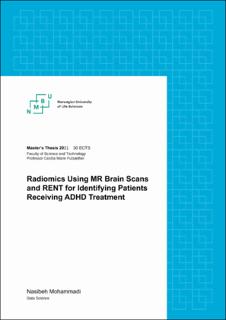| dc.contributor.advisor | Futsæther, Cecilia Marie | |
| dc.contributor.advisor | Tomic, Oliver | |
| dc.contributor.author | Mohammadi, Nasibeh | |
| dc.date.accessioned | 2021-11-16T10:25:21Z | |
| dc.date.available | 2021-11-16T10:25:21Z | |
| dc.date.issued | 2021 | |
| dc.identifier.uri | https://hdl.handle.net/11250/2829804 | |
| dc.description.abstract | The core purpose of this thesis was to investigate whether the methylphenidate-based (MPH) treatment of male children patients having attention-deficit/hyperactivity disorder (ADHD) led to changes to five subcortical brain structures (hippocampus, caudate, pallidum, putamen, and thalamus). The methylphenidate treated trials were compared to the placebo group. This was explored by using magnetic resonance (MR) images obtained from the effects of Psychotropic drugs On Developing brain (ePOD) study.
A radiomics approach was exploited to extract descriptors from T1-weighted MR images. Radiomics features including Local Binary Pattern (LBP), shape features and several texture features were derived from the right and left side of the chosen subcortical structures. In this context, a new feature extraction program for generating 3D LBP biomarkers was developed and a new feature selection method Repeated Elastic Net Technique (RENT) appropriate for short-wide datasets were utilised. Thereafter, four different classification experiments were used to predict the medication class (medicated vs placebo) by using a nested cross-validation algorithm and nine supervised classifiers. The area under receiving operator curve (AUC) metric was used for evaluating the performance of classification tasks.
The performance scores suggested that there was a detectable change in the selected brain structures using MPH medication. The classification models showed AUC scores mostly above 85% especially in experiments where LBP features were used as stand-alone features or in addition to standard radiomics features. It appears that the LBP features were the most informative descriptor in this study.
The classification results were approximately the same in experiments with correlated features and without correlated features. Additionally, the higher performance obtained in our study on the same dataset as in a previous study exploiting several feature selectors indicated the capability of our feature selection method (RENT) in selecting robust features. | en_US |
| dc.language.iso | eng | en_US |
| dc.publisher | Norwegian University of Life Sciences, Ås | en_US |
| dc.rights | Attribution-NonCommercial-NoDerivatives 4.0 Internasjonal | * |
| dc.rights.uri | http://creativecommons.org/licenses/by-nc-nd/4.0/deed.no | * |
| dc.subject | ADHD | en_US |
| dc.subject | Radiomics | en_US |
| dc.subject | Machine learning | en_US |
| dc.title | Radiomics using MR brain scans and RENT for identifying patients receiving ADHD treatment | en_US |
| dc.type | Master thesis | en_US |
| dc.subject.nsi | VDP::Technology: 500 | en_US |
| dc.description.localcode | M-MF | en_US |

